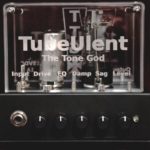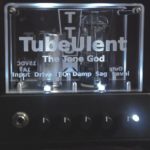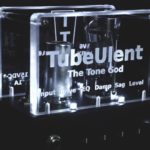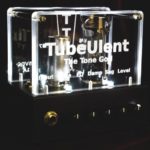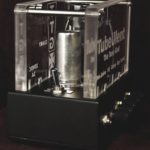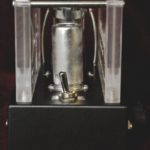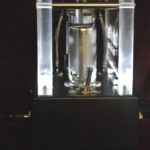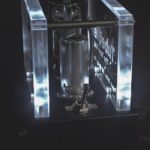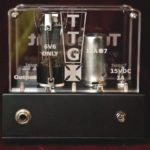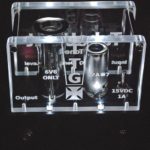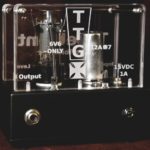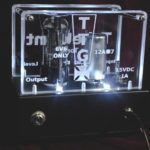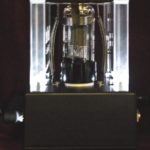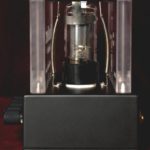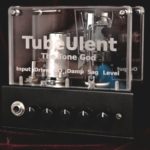TubeUlent
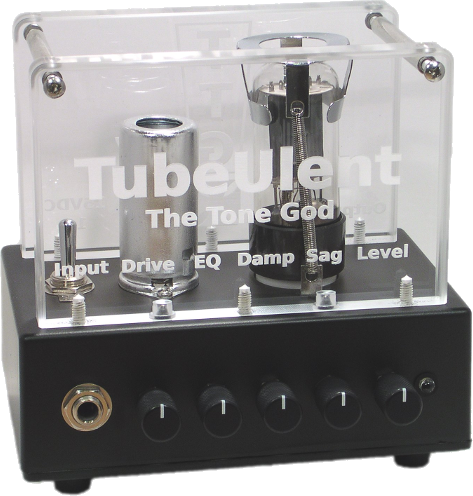
$400Add to cart
The best way to describe the TubeUlent is a tube amplifier that has been reduced in size and weight, with the final output configured to operate as a preamp. This allows a player to plug the TubeUlent into any piece of equipment that will accept a standard effect. The TubeUlent sounds like a tube amplifier because the core of the TubeUlent is a tube amplifier, so it behaves as if you’re playing a full size tube amp. The TubeUlent will distort when driven hard or will remain clean at lower volumes, all the while maintaining that warm sound that tubes are known for.
No techniques have been used to artificially create distortion in the tubes. No extra gain stages – no artificial clipping techniques – no starving voltages. The distortion created by the TubeUlent is the same type that occurs in full size tube amps. The final output level can be adjusted without causing any changes to the tube response.
The advantages of using the TubeUlent as a preamp verses a full size tube amplifier include:
Smaller size and lighter weight makes for a more portable performance rig.
Rugged construction requires less maintenance and provides higher reliability than most amplifiers.
No major reliance on type or model of final amplifier. Just about any amplifier (tube or solid state) can be used, but the player still benefits from tube amplifier response characteristics, and the warmth of tubes.
The output power of the final amplifier does not affect the response of the TubeUlent. The amplifier can be a headphone amp, a practice amp, or a medium to high power amp. This facilitates the scaling of the final output volume to suit the situation without affecting tube response – very useful for recording as well as live performance.
Other effects can be used before and/or after the TubeUlent, providing a broader range of tonal possibilities that in some cases would be difficult to do with full size tube amplifiers, such as reverb after distortion.
Damp and Sag Controls
Other controls have been added to allow the player to adjust parameters of the tube amplifier’s behaviour that are normally not accessible with full size tube amplifiers. These controls not only affect the tone of the amplifier, but also enable you to “dial in” exactly how you would like your tube amplifier to react to your playing.
Damp Control
Most tube amplifiers have what is called a negative feedback loop. This involves taking signal from the output and reintroducing the signal into the amplifier signal path where it is out of phase. When fed back out of phase, larger amplitude frequencies on the output will attenuate those frequencies in the amplifier.
The original purpose of this loop was to reduce the amount of distortion at the output, as the higher output signals that create distortion would be suppressed by the negative feedback loop. This loop also affects how much input signal it takes to get the amp to distort. When the amp did distort the amount of distortion amongst the various frequencies would be more balanced.
The amount of negative feedback used in tube amplifiers varies with each model / manufacturer. Earlier amplifiers had little or no negative feedback, while later amplifiers had more negative feedback. The added negative feedback resulted in amplifiers that were cleaner at loud volumes, but also displayed a more restricted feel.
The TubeUlent simulates the negative feedback loop with the amount of feedback adjusted by the Damp control. Unlike most tube amplifiers you can adjust the amount of negative feedback to a level you like. You can add large amounts of negative feedback (counter-clockwise rotation) to keep you signal cleaner and give a “dampened” feel to your playing or you can lower the amount (clockwise rotation) to the point where negative feedback is essentially removed, giving the tube amplifier an “open” feeling.
Sag Control
When tube amplifiers distort, the tubes are trying to generate more output than the power supply can deliver. When the limits of the power supply are reached using large signals, the amplifier’s response will become restricted, as the power supply attempts to catch up with the power demands. This behaviour is often described as “sag’.
The amount of sag an amplifier has varies with each model, and even from amp to amp of the same model, as there are many factors that determine how much sag an amplifier will have. Solid state vs. tube rectifier; different rectifier tubes; power transformers; power supply filtering; and other factors all control the sag response of a tube amplifier. Earlier tube amplifiers had quite a bit of power supply sag, thus being referred to as “loose” feeling. Later amplifiers had less sag, while modern amplifiers have very little sag and are considered “stiff”.
The TubeUlent not only simulates this amplifier characteristic – you are capable of adjusting how much occurs with the Sag control. Instead of having to change components or use switches one can now dial in the desired amount. The amount can range from a stiff modern response (counter-clockwise rotation) to a loose, vintage amplifier sound (clockwise rotation).
Tubes
Because the TubeUlent‘s core is a tube amplifier, the tubes play an important role in the sound. Many of the same factors that affect the sound of full size tube amps such as different tube brands and in some cases tube types also apply to the TubeUlent.
As with a full size tube amplifier, using different tube brands will change the sound of the TubeUlent. Some players like newer design tubes for brighter sounds. Other players like mellow, smoother tones that older style tubes have. By changing the tubes in the TubeUlent with different brands you can get a sound to suit your preference.
The player can also adjust the gain structure of the TubeUlent by changing the preamp tube to one of a different type/gain. The TubeUlent will accept preamp tubes such as the 12AX7, 5751, 12AT7, 12AY7, 12AV7, 12AU7, etc. (Descending order of gain level)
The TubeUlent is designed to maximize the life span of the tubes without sacrificing tone. Besides reducing maintenance time and costs, one can put resources into finding a set of tubes that suits their taste without having to worry about replacing the tubes a short time later.
Portability and Durability
Unlike full size tube amplifiers the TubeUlent is small and light. Weighing less than 1.5 Kg (3.31 lbs.) with the supplied power adaptor and the TubeUlent itself measuring approximately 145mm x 117mm x 144mm (5.7 inches x 4.6 inches x 5.65 inches), the TubeUlent literally fits in a briefcase. The universal power supply provided with the TubeUlent can be used worldwide with the correct AC cord, or an adaptor of appropriate rating can be used. There is no need for power conversion equipment or modification.
The TubeUlent has been designed and built for the rigours of the performing musician. With the exception of the tubes themselves, TubeUlent can withstand high levels of abuse – be it high force impact or long periods of vibration such as that caused by transport or performance events. External and internal hardware and finishes have been selected for high resilience.
Safety Features
The TubeUlent has many safety features that normal tube amplifiers do not have.
On power-up TubeUlent will run a self-diagnostic routine on tubes and internal circuitry to ensure everything is operating properly and safely before exiting standby mode. The TubeUlent does not have an external standby switch. Instead, the TubeUlent enters standby mode automatically on power-up and remains in that mode until the tubes reach proper operating temperature. Once operating, TubeUlent does not need to be turned off or put in standby until the performance is over. This eliminates issues caused by the misuse of standby switches.
If a failure occurs during operation TubeUlent will turn the tubes and related subsystems off, thus protecting itself and externally connected equipment from damage, and most importantly protecting the user from injury. A slowly blinking front panel LED is an indication of an internal error, at which point TubeUlent will enter standby mode until it is turned off and the issue is addressed. Failures that TubeUlent will recognize range from tube failure to internal circuit problems.
Manual
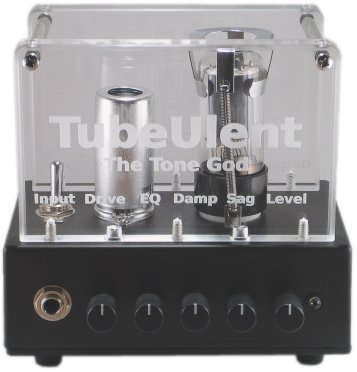
Front Panel
Input: Input signal jack. The input has the same characteristics as most common tube amplifiers. It will accept the same types of signals that a standard tube amplifier would.
Drive: Adjusts the signal level. This control acts similar to the volume control on a non-master volume amplifier. Higher signal levels create more distortion. Clockwise for more signal. Counter-clockwise for less signal.
EQ: A simple tone control. Clockwise for more highs, counter clockwise for more lows. The control interacts with the Drive control. Some settings will act differently depending on the Drive control setting.
Damp: Adjusts the amount of simulated negative feedback. Clockwise for less negative feedback. Counter-clockwise for more negative feedback. More negative feedback reduces distortion response.
Sag: Simulates the power supply drop tube amplifiers display when driven hard. Clockwise for more sag, counter-clockwise for less sag. The sag characteristic may not become apparent until the signal reaches the necessary level.
Level: Final output level. Clockwise for higher output level, counter-clockwise for lower output level. The setting of this control does not affect the other control settings.
Power LED
The power LED has four states.
No Light: TubeUlent is off.
Quick Strobe / Flicker: Occurs when TubeUlent is turned on. TubeUlent is in standby mode waiting for the tubes to heat up which should take a few moments. TubeUlent will automatically switch out of standby when the tubes are heated up.
Solid Light On: TubeUlent is on and operating normally.
Slow Blink: TubeUlent has shut down due to an error. Turn off TubeUlent and check your power supply and tubes to make sure everything is correct. If the TubeUlent continues to show an error condition contact us for service.
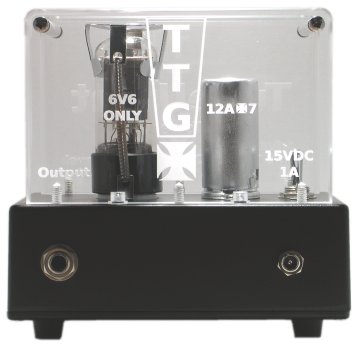
Back Panel
Output: Output signal jack. The output signal characteristics are similar to that of many effects.
15VDC 1A: Plug the power supply adaptor (included) into this jack.
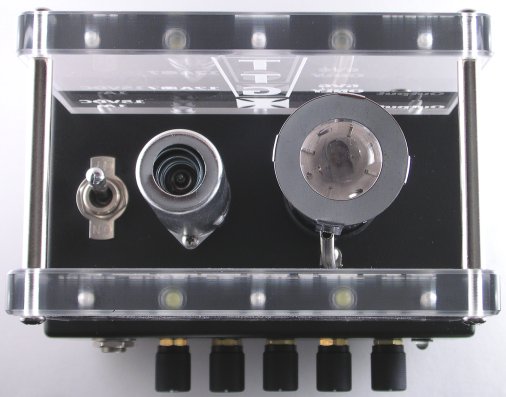
Top Panel
Power Switch: Switch that controls power to the TubeUlent. When the power switch position is toward the front panel the power is on. When the power switch position is toward the back panel the power is off.
Preamp Tube: The TubeUlent will except just any tube in the 12A_7 family or a tube of similar characteristics. Common tubes used are 12AX7, 5751, 12AT7, 12AY7, 12AV7, 12AU7.
Power Tube: The TubeUlent is designed only for the 6V6 tube. Do NOT attempt to use other power tube types in the TubeUlent.
Example Wiring Configurations
Here are some common wiring configurations for the TubeUlent which can be mixed depending on the musician’s needs.
Guitar with a standard amplifier:
![]()
Guitar with standard effect(s) before and/or after the TubeUlent:
Using the TubeUlent in the amplifier’s effects loop:

Harmonica microphone with a standard amplifier:

Guitar with a P.A. amplifier:
![]()
Specifications
Power Jack Type: 2.1mm center positive barrel
Power Input: 15VDC @ 1A (Adapter Supplied)
Power Adapter Input: 100V-240V AC 50-60Hz 800mA
Power Consumption:
Standby – Approx. 1A (Tubes heating)
Operating – Approx. 500mA (Tubes heated)
Input Impedance: 1Meg Ohms
Output Voltage: Approx. 4Vpp (11.25 dBu / 9.031 dBV @ 600 ohms)
Tubes:
Preamp Tube – 12AX7 or similar tube family specification
Power Tube – 6V6
External Dimensions
Length:145mm (5.7 inches)
Width: 117mm (4.6 inches)
Height: 144mm (5.65 inches)
Weight: 1.5 Kg (3.31 lbs.) with supplied adapter
Specifications subject to change without notice
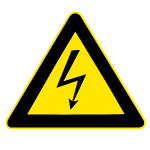
Warning
The TubeUlent contains lethal voltages
There are no user serviceable parts inside
Do not immerse the TubeUlent in liquid
Do NOT attempt to open the TubeUlent
Frequently Asked Questions
Most frequent questions and answers
Can I use effects on the input ?
Yes. You can use effects on the input just like you would with a real tube amplifier.
Can I use effects on the output ?
Yes. The TubeUlent output is similar to that of most effects.
Will operating with the output unconnected cause any damage ?
No. The TubeUlent can run with the output disconnected without any problems.
Can I drive a speaker with the TubeUlent ?
No. The TubeUlent is not an amplifier. It is an effect. If you want to drive a speaker you will need an amplifier.
Will changing tube brands change the sound ?
Yes. Just like with a full size tube amplifier the sound of the TubeUlent will change with different tube brands.
Can I use other types of preamp tubes other then the 12AX7 ?
Yes. You can use other preamp tubes that have similar specifications as the 12AX7. Possible tube substitutions include 12AX7, 5751, 12AT7, 12AY7, 12AV7, 12AU7, etc. Change the tube type can affect not only the sound of the TubeUlent but also the gain response.
Can I use other types of power tubes other then the 6V6 ?
NO! The TubeUlent is designed for the 6V6 tube only. Do not attempt to use other power tube types in the TubeUlent.
Will running with higher signal levels shorten life span ?
No. The TubeUlent can run at maximum without threat of damage.
Does the TubeUlent need any maintenance like other tube amplifiers ?
Other than tube replacement when required the TubeUlent should not need any maintenance. This includes filter capacitor replacement, biasing, and other work required by full size tube amplifiers.
What AC input voltages are supported ?
The adaptor supplied should work with 100V – 240V 50Hz – 60Hz AC input voltage. All that is required is a power cable with the correct fittings.
What are the power requirements ?
The TubeUlent requires a power supply with a minimum 15 Volts DC @ 1 Amp through a 2.1mm positive centre barrel plug. Note: You should only use the adaptor supplied.
My TubeUlent continues to show an error even when I change the tubes with a known good set and the power adapter's indicator is on. What should I do ?
There may be an internal problem with your TubeUlent. Contact Service with your information to have your TubeUlent repaired.
Do I need to turn off the TubeUlent or put it into standby during short periods of non-performance ?
No. You can leave the TubeUlent on until you are done playing.
Does the final output configuration affect the response of the TubeUlent ?
No. The TubeUlent will perform the same no matter the final output configuration. What may change is how well the final output system reproduces the signal coming from the TubeUlent.
Can I use the TubeUlent for bass ?
Yes. You can use the TubeUlent for bass.
Can I use the TubeUlent with a harmonica microphone ?
Yes. You can use the TubeUlent with a harmonica microphone if the microphone is configured to feed an input similar to a guitar amplifier. (e.g. High Impedance)
What amplifier class is the TubeUlent ?
The tube preamp and tube power amp section of the TubeUlent is Class A.
Where is the serial number located on the TubeUlent ?
The serial number can be seen when looking through the back name plate from above.
What tubes do the TubeUlent ship with ?
The preamp tube is an Electro-Harmonix EH-12AX7. The power tube is an Electro-Harmonix EH-6V6GT
Is the TubeUlent circuitry "all analog" ?
The TubeUlent‘s audio signal path is all analog.
Is the TubeUlent circuitry "all tube" ?
No. From the input to just before the output the circuit is all tube. The final output has a buffer to protect equipment and better condition the output signal for use. The circuitry has been carefully designed to not impart any change on the signal from the tubes including frequency response and extra distortion so you get the true sound of the tubes.
Sound Samples
These samples were not recorded to maximize the potential of the TubeUlent but to give the best platform of comparison by eliminating as many external variables as possible. It is hoped that these samples will give the best idea of what the TubeUlent sound is including it’s limitations.
Guitars
Les Paul: 1993 Gibson Les Paul Standard (Stock). Both pickups selected with volume and tone controls at maximum. Standard tuning.
Stratocaster: 1989 Fender Stratocaster ’68 Reissue (Stock). Middle pickup selected with volume and tone controls at maximum. Standard tuning.
Strings are Dean Markley’s 10’s regular
Harmonica
Harmonicas: Hohner Special 20 (Stock) in the key of A unless another key is specified
Microphone: Shure 520SL with mid 1950’s controlled magnetic element
Recording Setup
Guitar is connected directly to the TubeUlent
Harmonica microphone is connected directly to the TubeUlent
Tubes used in the TubeUlent for recording are:
Preamp Tube: Electro-Harmonix EH-12AX7
Power Tube: Electro-Harmonix EH-6V6GT
The TubeUlent is connected directly to the power amp
Power Amp: Samson Servo 120 Stereo Power Amp (set to mono)
Cabinet: Marshall JCM Lead Series 2 x 12 cabinet w/stock celestions
Mic: Rodes NT-5 Condenser Mic
Preamp: API A2D Mic Preamp and A/D Converter
Software: Pro Tools (DAW)
Les Paul
Drive
EQ
Damp
Sag
Sample




































Stratocaster
Drive
EQ
Damp
Sag
Sample




































Rhythm / Lead

Both these tracks use this setting for both lead and rhythm guitar
Les Paul is used for the rhythm guitar on both tracks
Stratocaster
Les Paul
Harmonica
The following setting is used for all three samples with harmonicas of different keys
Drive

EQ

Damp

Sag

Key of A
Key of C
Key of F
A collection of various settings using harmonica
Name
Clean
Slight Break Up
Tweed
Setting






